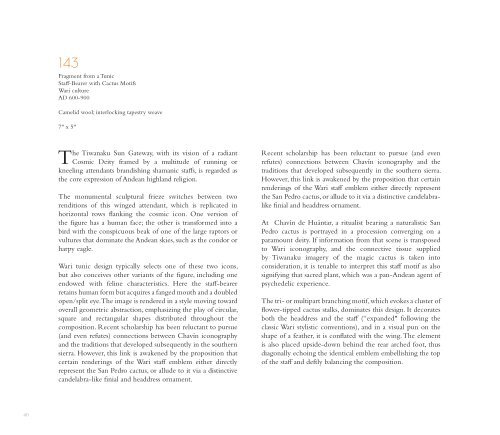You also want an ePaper? Increase the reach of your titles
YUMPU automatically turns print PDFs into web optimized ePapers that Google loves.
143<br />
Fragment from a Tunic<br />
Staff-Bearer with Cactus Motifs<br />
Wari culture<br />
AD 600-900<br />
Camelid wool; interlocking tapestry weave<br />
7" x 5"<br />
The Tiwanaku Sun Gateway, with its vision of a radiant<br />
Cosmic Deity framed by a multitude of running or<br />
kneeling attendants brandishing shamanic staffs, is regarded as<br />
<strong>the</strong> core expression of Andean highland religion.<br />
The monumental sculptural frieze switches between two<br />
renditions of this winged attendant, which is replicated in<br />
horizontal rows flanking <strong>the</strong> cosmic icon. One version of<br />
<strong>the</strong> figure has a human face; <strong>the</strong> o<strong>the</strong>r is transformed into a<br />
bird with <strong>the</strong> conspicuous beak of one of <strong>the</strong> large raptors or<br />
vultures that dominate <strong>the</strong> Andean skies, such as <strong>the</strong> condor or<br />
harpy eagle.<br />
Wari tunic design typically selects one of <strong>the</strong>se two icons,<br />
but also conceives o<strong>the</strong>r variants of <strong>the</strong> figure, including one<br />
endowed with feline characteristics. Here <strong>the</strong> staff-bearer<br />
retains human form but acquires a fanged mouth and a doubled<br />
open/split eye. The image is rendered in a style moving toward<br />
overall geometric abstraction, emphasizing <strong>the</strong> play of circular,<br />
square and rectangular shapes distributed throughout <strong>the</strong><br />
composition. Recent scholarship has been reluctant to pursue<br />
(and even refutes) connections between Chavín iconography<br />
and <strong>the</strong> traditions that developed subsequently in <strong>the</strong> sou<strong>the</strong>rn<br />
sierra. However, this link is awakened by <strong>the</strong> proposition that<br />
certain renderings of <strong>the</strong> Wari staff emblem ei<strong>the</strong>r directly<br />
represent <strong>the</strong> San Pedro cactus, or allude to it via a distinctive<br />
candelabra-like finial and headdress ornament.<br />
Recent scholarship has been reluctant to pursue (and even<br />
refutes) connections between Chavín iconography and <strong>the</strong><br />
traditions that developed subsequently in <strong>the</strong> sou<strong>the</strong>rn sierra.<br />
However, this link is awakened by <strong>the</strong> proposition that certain<br />
renderings of <strong>the</strong> Wari staff emblem ei<strong>the</strong>r directly represent<br />
<strong>the</strong> San Pedro cactus, or allude to it via a distinctive candelabralike<br />
finial and headdress ornament.<br />
At Chavín de Huántar, a ritualist bearing a naturalistic San<br />
Pedro cactus is portrayed in a procession converging on a<br />
paramount deity. If information from that scene is transposed<br />
to Wari iconography, and <strong>the</strong> connective tissue supplied<br />
by Tiwanaku imagery of <strong>the</strong> magic cactus is taken into<br />
consideration, it is tenable to interpret this staff motif as also<br />
signifying that sacred plant, which was a pan-Andean agent of<br />
psychedelic experience.<br />
The tri- or multipart branching motif, which evokes a cluster of<br />
flower-tipped cactus stalks, dominates this design. It decorates<br />
both <strong>the</strong> headdress and <strong>the</strong> staff (“expanded" following <strong>the</strong><br />
classic Wari stylistic conventions), and in a visual pun on <strong>the</strong><br />
shape of a fea<strong>the</strong>r, it is conflated with <strong>the</strong> wing. The element<br />
is also placed upside-down behind <strong>the</strong> rear arched foot, thus<br />
diagonally echoing <strong>the</strong> identical emblem embellishing <strong>the</strong> top<br />
of <strong>the</strong> staff and deftly balancing <strong>the</strong> composition.<br />
40







